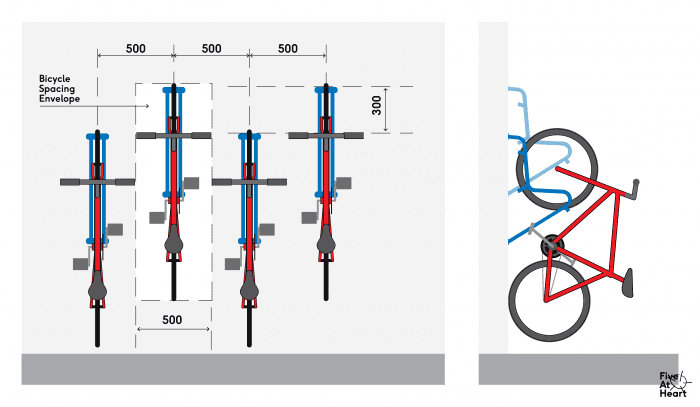When designing the perfect bike parking facility in Australia, it’s important to know the ins and outs of the AS 2890.3 (2015) – that is, the Australian Standard for Bike Parking Facilities.
Unfortunately, the 36-page document is not the most riveting read. So we at Five at Heart, with the help of our CEO, Mark Rossiter (who sat on the board that developed the standard), have decided to break down the most important aspects of the code into a simple blog post for your reading pleasure. No time? Check out this great 3-minute video instead.
Here’s what you need to know.
AS2890.3 (2015) was developed with the assistance of leaders in the industry, which means that by following the AS 2890.3 you are making sure you are designing the most functional facility. Since we at Five at Heart are riders ourselves, we understandably believe these standards are integral to the successful design of end-of-trip facilities. Designing your bike parking facilities to Australian Standards ensures that your business or client has the best possible, carefully considered, future-proof product on the marketplace, and that your product is suitable for all kinds of users. Which is important, because, well, quality is important, accessibility is important, and the AS 2890.3 sets the standard for accessible, quality end-of-trip bike parking designs in Australia.
Happier, healthier employees means happier, healthier tenants. For this reason, Australia’s Green Star certification system requires bike parking to be designed to Australian Standards in order to be eligible for the Green Star point for end-of-trip facilities.
Local governments and Green Star rules rely on AS2890.3 to determine the requirements for compliant bicycle parking facilities. Failure to follow their guidelines can result in developmental approval delays, the requirement to provide additional space for bike parking, the requirement to replace non-compliant product designs and monetary fines.
In other words, ignoring Australian Standards essentially means that you are creating a product that could cause headaches down the road. So, in order to ensure that your design meets all requisite guidelines, and that you are garnering Green Star points, we recommend following the guidelines or calling on someone intimately familiar with the rules in order to point you in the right direction.
The 20% horizontal minimum requirement is often the most overlooked aspect of the AS2890.3 and is key to providing accessibility to riders unable to lift a bicycle and for the parking of non-standard bicycles.
It essentially means that 20% of the bike parking spaces you provide in your facility must allow for the horizontal parking of bikes. Our Wishbone is the perfect solution for this type of parking.
The bicycle spacing envelope is the overall footprint of the average bicycle and forms the starting point of all required bike parking dimensions and specifications. The dimensions of the bicycle spacing envelope are 1800mm x 1200mm x 500mm.


Horizontal static bicycle racks – like our Wishbone and Hoop – are spaced at 1000mm centres. This ensures that each bike has the correct 500mm spacing when storing two bikes on each rail.

Dynamic racks require bicycles to be moved in order to create the minimum bicycle spacing envelope, and need to comply with the bicycle spacing envelope at the point of insertion and removal. This way, a dynamic rack can store the bike at a reduced centre of 400mm provided the racks are staggered with a 300mm vertical offset. See our Track design for a clear AS 2890.3 compliant example.

Dynamic double-tiered designs also allow for 400mm centers, using a vertical offset of 300mm, saving even more space. Our Arc is designed according to these standards, as shown in the image below.

Finally, keep in mind that aisle width is measured from bicycle envelope to bicycle envelope, not from rack to rack! This is the other most overlooked aspect of non-compliant end-of-trip facility designs.

Double-tier designs require 2 meters between each envelope.

We understand that these standards can, at times, be somewhat complex. We’re here to help! Get in touch and let us run you through how your space could be better for the client and user.